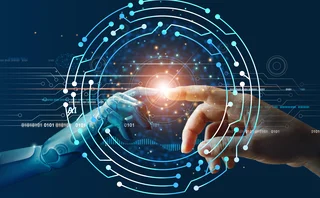Opening Cross: Balancing and Evolving with Your Greatest Asset
A company's greatest asset isn't the products it creates, or even how it uses them; it's the people who create them.

In a voice somewhere between Siri and Stephen Hawking, X29a4 thanks the gathered audience, lists those it couldn’t have won without—its datacenter, FPGA supplier, and datafeed provider—and gives a tearful thank-you to its parents Algo BestEx29 and Algo TCAa4 (and ,of course, God—aka Skynet).
At this week’s Inside Market Data and Inside Reference Data Awards, we recognize the latest technological achievements, but it’s the individuals who sweat and toil to create these capabilities who we praise for their success or hold accountable for their failure.
And for each and every company up for an award, it’s important to remember that their greatest asset is not a piece of hardware or software, but rather the people behind it, who will be creating new code and chips long after today’s components have been rendered obsolete.
That’s why I’m always heartened by stories that are fundamentally about people, rather than the products they create. So stories like those about low-latency data and trading infrastructure provider Fixnetix hiring a raft of new salespeople, or Swiss momentum analytics vendor Trendrating planning to double its headcount over the next year fill me with encouragement that—in a time when so many technology processes are geared towards eliminating the need for people—some still see a need to go long on the human asset. After all, using technology to make a process more efficient doesn’t automatically mean you should cull those people—and their experience—from your roster. But it does mean you can have them focus on high-touch, high-value areas instead of the commoditized areas that are ripe for automation.
After all, without the people, we’d be awarding recognition to specific microwave dishes on towers for their low-latency connectivity. But really, how far is this from reality? OK, so the idea of an algorithm ambling up to accept their award then getting into it with a Big Data program at the afterparty is still a fiction. But the time when people will become even further removed from the engineering and configuration processes behind low-latency networks and trading may not be as distant as we think.
For example, the advent of software-defined networks and microwave connectivity means that not only can a network administrator configure wireless connectivity across different routes on the fly, but that significant parts of this process can be automated. Instead of waiting for network providers to dig trenches and lay new fiber routes, antennae can be remotely re-directed to face another direction, to obtain a better or faster signal, or to route trade flow to a different marketplace. Coupling this with network monitoring tools could allow these antennae to automatically re-route data flows based on unexpected latency, adverse weather that might affect a signal, or in the event of fault equipment. A human may still be required to set up the rules by which the network would decide what to do under certain circumstances, but it isn’t too far-fetched to say that person could then move onto more strategic initiatives, like deciding which marketplaces are worth adding to the network, or how to approach trading in new regions, and leave the execution to the machines.
Or maybe when drawing this Terminator-like fine line between man and machine, I shouldn’t use “execution” and “machines” in the same breath. Because at the end of the day, it’s not about pitting one against the other: each needs the other in order to evolve, and this industry’s greatest future successes will come from finding the right balance between our greatest assets and the new assets they create.
Only users who have a paid subscription or are part of a corporate subscription are able to print or copy content.
To access these options, along with all other subscription benefits, please contact info@waterstechnology.com or view our subscription options here: http://subscriptions.waterstechnology.com/subscribe
You are currently unable to print this content. Please contact info@waterstechnology.com to find out more.
You are currently unable to copy this content. Please contact info@waterstechnology.com to find out more.
Copyright Infopro Digital Limited. All rights reserved.
As outlined in our terms and conditions, https://www.infopro-digital.com/terms-and-conditions/subscriptions/ (point 2.4), printing is limited to a single copy.
If you would like to purchase additional rights please email info@waterstechnology.com
Copyright Infopro Digital Limited. All rights reserved.
You may share this content using our article tools. As outlined in our terms and conditions, https://www.infopro-digital.com/terms-and-conditions/subscriptions/ (clause 2.4), an Authorised User may only make one copy of the materials for their own personal use. You must also comply with the restrictions in clause 2.5.
If you would like to purchase additional rights please email info@waterstechnology.com
More on Emerging Technologies
BlackRock tests ‘quantum cognition’ AI for high-yield bond picks
The proof of concept uses the Qognitive machine learning model to find liquid substitutes for hard-to-trade securities.
JP Morgan, Eurex push for DLT-driven collateral management
The high-stakes project could be a litmus test for the use of blockchain technology in the capital markets.
For AI’s magic hammer, every problem becomes a nail
A survey by Risk.net finds that banks are embracing a twin-track approach to AI in the front office: productivity tools today; transformation tomorrow.
On GenAI, Citi moves from firm-wide ban to internal roll-out
The bank adopted three specific inward-facing use cases with a unified framework behind them.
How a Chinese AI firm shook the tech world
DeepSeek’s AI model is the very ethos of doing what you can with what you have.
To unlock $40T private markets, Hamilton Lane embraced automation
In search of greater transparency and higher quality data, asset managers are taking a tech-first approach to resource gathering in an area that has major data problems.
Waters Wavelength Ep. 304: Nice Actimize’s Lee Garf
Lee joins to discuss changes in communication platforms over the last few years.
DTCC revamps data distribution, collection efforts with cloud, AI
The US clearinghouse is evaluating the possibilities that cloud and AI offer to streamline the processes by which it collects and makes data available to market participants.








